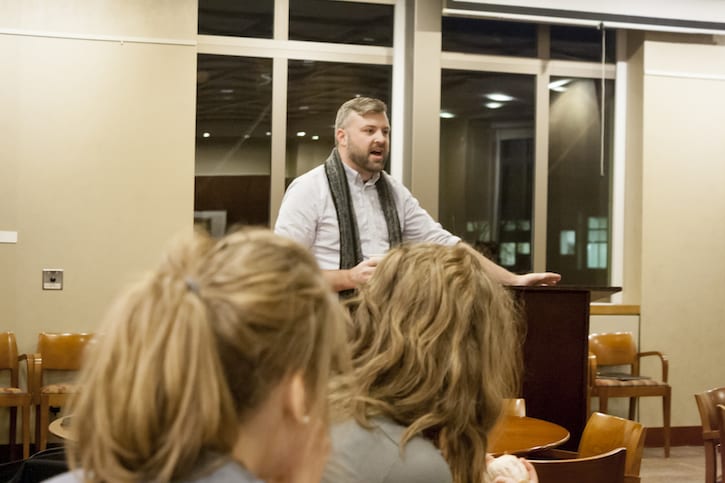
On Thursday, Nov. 20, the Valhalla ballroom hosted the Green Faith Conference, an event sponsored jointly by the Interfaith and Environmental Coalitions. The purpose of the event was to promote discussion of how one’s personal religious beliefs inform and affect environmental attitudes. The featured speaker of the evening was Instructor of Religion Jacob Erickson. He teaches REL 121: The Green Bible, a first-year religion class that discusses similar topics to those of the Green Faith Conference. Erickson believes that discussion of the topic is long overdue.
“Connections between religious dialogue and environmental ethics have been happening for decades,” he said, “But it’s not brought up around here. Not in chapel or even around campus.”
Erickson outlined how religious traditions harbor ecological concerns and how many faiths call for practitioners to “love the Earth” and have an obligation to non-human life. He juxtaposed these viewpoints with traditions that exacerbate environmental problems, such as a sense of non-attachment to the physical world. As an example, he used the Bible verse Genesis 1:28, which says that humans are given “dominion to subdue the Earth.”
In reference to these harmful practices, Erickson said, “traditions are like large spice cabinets, and sometimes you need to try some new recipes.”
He then concluded his speech by discussing two movements he believes have done exceptionally well in promoting religious-environmental relations. The first was recent reforms by the Catholic church. The Vatican is the world’s first carbon-neutral state, and Pope Francis has declared that water is a basic human right. Pope Francis has also engaged in unprecedented communication with the Eastern Orthodox church on environmental topics.
The second movement mentioned was Interfaith Power and Light, an organization that collects environmental statements from hundreds of congregations to show the varying religious perspectives on environmentalism.
After the conclusion of Erickson’s speech, attendees of the Green Faith event divided into smaller groups for discussion. Each table was given discussion questions. The discussion questions were divided into three categories: personal, inter-religious and contemporary context.
The personal values category primarily discussed how upbringing affects environmental beliefs. Much of the discussion of this topic involved the rural versus urban dynamic. Those from small towns appeared to have a strong belief in the necessity for environmental balance. Also discussed was how growing up specifically in Minnesota is a large factor in many students’ ecological beliefs due to the extreme weather conditions.
The inter-religion category sought people’s thoughts on how various faiths cooperate on environmental issues. The general consensus was that churches do not communicate with each other nearly enough. Erickson explained to his discussion table the contradicting ways religion impacts the environment by using elephant poaching as an example. On one hand, the mystical and spiritual symbolism of the elephant has prompted many Western countries to take action to end elephant poaching. On the other hand, Christians often enable poaching through demand for ivory church ornaments.
The contemporary context category asked how religious environmentalism could be further explored at St. Olaf. The group members concluded that student clubs and organizations could weave this issue into their discussions and events.
Eventually, time was up for discussion and everyone regrouped to hear Emma Burck ’17, who offered the concluding remarks.
“We’re hoping to continue this discussion into next semester, next year,” she said. “Maybe we’ll even have a panel of speakers in the future.”
mayo1@stolaf.edu
Photo Credit: SARAH BARTON/MANITOU MESSENGER

